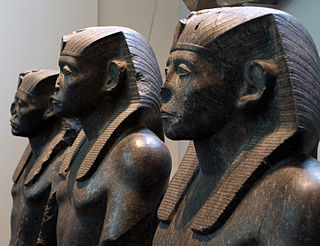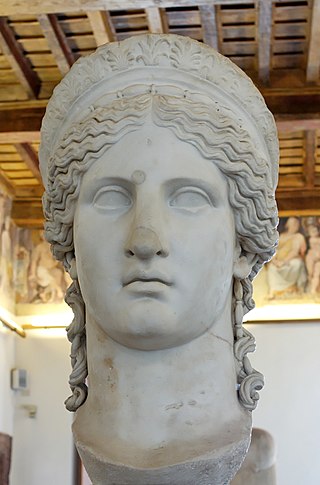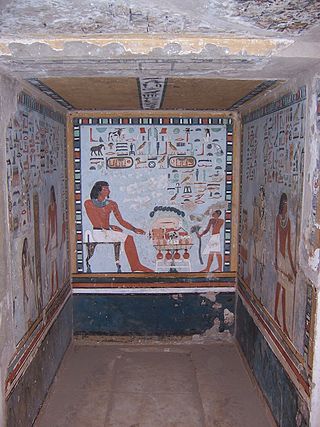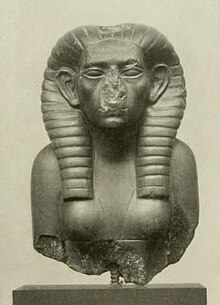
Amenemhat III, also known as Amenemhet III, was a pharaoh of ancient Egypt and the sixth king of the Twelfth Dynasty of the Middle Kingdom. He was elevated to throne as co-regent by his father Senusret III, with whom he shared the throne as the active king for twenty years. During his reign, Egypt attained its cultural and economic zenith of the Middle Kingdom.

Sobekneferu or Neferusobek was a pharaoh of ancient Egypt and the last ruler of the Twelfth Dynasty of the Middle Kingdom. She ascended to the throne following the death of Amenemhat IV, possibly her brother or husband, though their relationship is unproven. Instead, she asserted legitimacy through her father Amenemhat III. Her reign lasted 3 years, 10 months, and 24 days, according to the Turin King List.

Amenemhat IV was the seventh and penultimate king of the late Twelfth Dynasty of Egypt during the late Middle Kingdom period. He arguably ruled around 1786–1777 BC for about nine regnal years.

Khakaure Senusret III was a pharaoh of Egypt. He ruled from 1878 BC to 1839 BC during a time of great power and prosperity, and was the fifth king of the Twelfth Dynasty of the Middle Kingdom. He was a great pharaoh of the Twelfth Dynasty and is considered to rule at the height of the Middle Kingdom. Consequently, he is regarded as one of the sources for the legend about Sesostris. His military campaigns gave rise to an era of peace and economic prosperity that reduced the power of regional rulers and led to a revival in craftwork, trade, and urban development. Senusret III was among the few Egyptian kings who were deified and honored with a cult during their own lifetime.

Sedjefakare Kay Amenemhat VII was an Egyptian pharaoh of the early 13th Dynasty in the late Middle Kingdom.

The Mortuary Temple of Amenhotep III, also known as Kom el-Hettân, was built by the main architect Amenhotep, son of Hapu, for Pharaoh Amenhotep III during the 18th Dynasty of the New Kingdom. The mortuary temple is located on the Western bank of the Nile river, across from the eastern bank city of Luxor. During its time, the Mortuary Temple of Amenhotep III was the largest funerary complex in Thebes that was built. Only parts of the mortuary temple's layout remain, as well as the Colossi of Memnon, which are two large stone statues of Amenhotep III and his family guarding the entrance measuring 18 meters high. Because the mortuary temple was built relatively close to the river, the annual flooding caused the site to decay at a more rapid rate. New research indicates that a large majority of the destruction on the mortuary temple can be attributed to the effects of an earthquake. It was long speculated that the earthquake occurred around 27 BC; however, investigations into the mortuary temple and surrounding colossi have debunked this time frame and instead have demonstrated it occurred around 1200 BC. Additional earthquakes after the one in 1200 BC have not been ruled out. The Colossi of Memnon and Amenhotep III Temple Project have helped conserve the site as well as possible.

The German Archaeological Institute is a research institute in the field of archaeology. The DAI is a "federal agency" under the Federal Foreign Office of Germany.

Ameny Qemau was an Egyptian pharaoh of the early 13th Dynasty in the late Middle Kingdom.

The Juno Ludovisi is a colossal Roman marble head of the 1st century CE from an acrolithic statue of an idealized and youthful Antonia Minor as the goddess Juno. Added to the Ludovisi collection formed by Cardinal Ludovico Ludovisi, it is now in the Palazzo Altemps, Museo Nazionale Romano, Rome.

The National Museum of Sudan or Sudan National Museum, abbreviated SNM, is a two-story building, constructed in 1955 and established as national museum in 1971.

Uronarti is an island and archaeological site in the Nile just south of the Second Cataract in the north of Sudan. The site features a massive ancient fortress that still stands on its northern end. This fortress is one of many constructed along the Nile in Lower Nubia during the Middle Kingdom, beginning under the reign of Senusret I.
Khamerernebty II was an ancient Egyptian queen of the 4th Dynasty. She was a daughter of Pharaoh Khafre and Queen Khamerernebty I. She married her brother Menkaure and she was the mother of Prince Khuenre.

Raherka and Meresankh is a group statue of an ancient Egyptian couple of the 4th Dynasty or 5th Dynasty.

The Bust of Amenemhat V is a sculpture showing the head of the ancient Egyptian king Amenemhat V, who ruled at the beginning of the Thirteenth Dynasty. One of the major art works of this period, it is today in the Kunsthistorisches Museum in Vienna with the inventory number ÄS 37.

Sarenput II, also called Nubkaurenakht was an ancient Egyptian nomarch during the reign of pharaohs Senusret II and Senusret III of the 12th Dynasty.
The Temple of Satet or Satis was an ancient Egyptian temple dedicated to the goddess Satet, a personification of the Nile inundation. The temple was located on the Nile Valley island of Elephantine, Egypt. Founded during the late Predynastic Period around 3200 BC, it was enlarged and renovated several times from the Early Dynastic Period onwards over the next 3000 years until the Ptolemaic Period. The temple of Satet is the best example of an ancient Egyptian temple whose construction is attested over the entire pharaonic period.
Sebat was an ancient Egyptian king's daughter of the Twelfth Dynasty. Her only known title is king's daughter of his body. She is so far only attested on the back slab of a statue base found at Serabit el-Khadim on Sinai. The statues are now lost but once depicted a falcon, king Amenemhat I and king Senusret I. The inscription mentions at the top Amenemhat II and in a lower register Senusret I, the king's daughter Sebat, the king's wife Neferu, Amenemhat I and again Senusret I. From this evidence it seems clear that Sebat was the daughter of Senusret I and Neferu and the sister of Amenemhat II.

Sobeknakht was a king's daughter during the late 12th Dynasty or early 13th Dynasty of Ancient Egypt. She was the daughter of an unknown king and is shown on a copper statuette with a suckling child who is a prince.
Suty was an ancient Egyptian high official under pharaoh Ramesses II. He was overseer of the treasuries – thus responsible for the administration of the commodities coming to the royal palace – and overseer of troops. Suty is known from his decorated tomb at El Khawaled (Mostagedda), in Upper Egypt. He is also known from a sarcophagus that is now in the Cairo Egyptian Museum but most likely comes from this tomb. Shabtis with his name were found in burials of the Apis bulls at Saqqara. They were found close to Apis bulls that were buried in the year 16 and year 30 of the reign of Ramesses II. In year 24 a certain Panehesi was in offices as overseer of the treasuries, before the latter Tia occupied this office, so that Suty must have been in office around year 30 of king Ramesses II. This also indicates that Suty was involved in preparing the burials of these sacred animals. He is also known from several statues.
Dieter Arnold is a German archaeologist.















